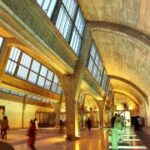The museum was originally Zhengyangmen East Station, commonly known as Beijing Station or Qianmen Station. Its construction is inseparable from the aggression of foreign powers against China. In the 23rd year of Guangxu in the Qing Dynasty (1897), the Tianjin-Lugouqiao Railway was completed and opened to traffic. The route runs from Tianjin Station to Lugouqiao. When the railway was extended to Fengtai, a railway from Fengtai to Majiabao was built.
In the 26th year of Guangxu (1900), the Eight-Power Allied Forces invaded China. In 1901, the British invaders forcibly extended the Tianjin-Lugouqiao Railway from Majiabao to Zhengyangmen (i.e., Qianmen) and began to build the ‘Jingfeng Railway Zhengyangmen East Station’, which was completed and put into use in 1906. It was the largest railway station in the country at that time. The building area of the station building is 3500 square meters. There are three platforms in the station, equipped with passenger ticket offices, information offices, luggage rooms, public telephones for passengers, radio telegraphs and other facilities. On September 15, 1959, the newly-built Beijing Station was opened for operation, and Zhengyangmen East Station was decommissioned, ending its historical mission as the ‘gateway to the capital’. In 2008, the station was renovated into the Beijing Railway Museum and officially opened to domestic and foreign audiences before the opening of the Beijing Olympics in August. This is one of the ‘Humanistic Olympics’ projects jointly organized by the Ministry of Railways and the Beijing Municipal Government. The Beijing Railway Museum has a total of four floors: three floors above ground and one floor underground. The first and second floors above ground are long-term exhibitions, which will display the humiliating, struggling, prosperous and glorious history of China’s railways for more than 130 years with a large number of cultural relics and historical pictures. Opening hours: Tuesday to Sunday all year round, 09:00 – 17:00; closed all day on Monday all year round; open from 09:00 to 17:00 on New Year’s Day, Spring Festival, Tomb Sweeping Day, Labor Day, Dragon Boat Festival, Mid-Autumn Festival and National Day.Zhengyangmen Station of China Railway Museum
The museum was originally Zhengyangmen East Station, commonly known as Beijing Station or Qianmen St[...]









